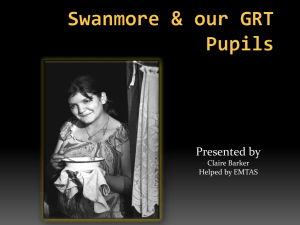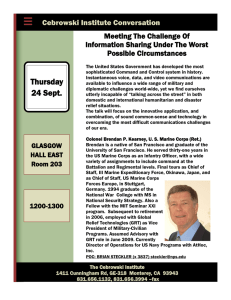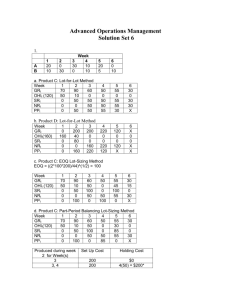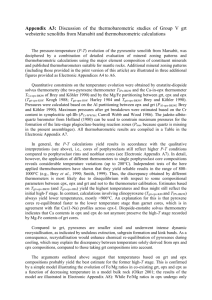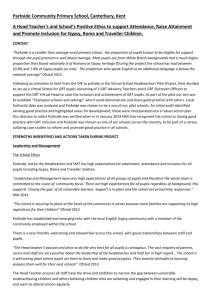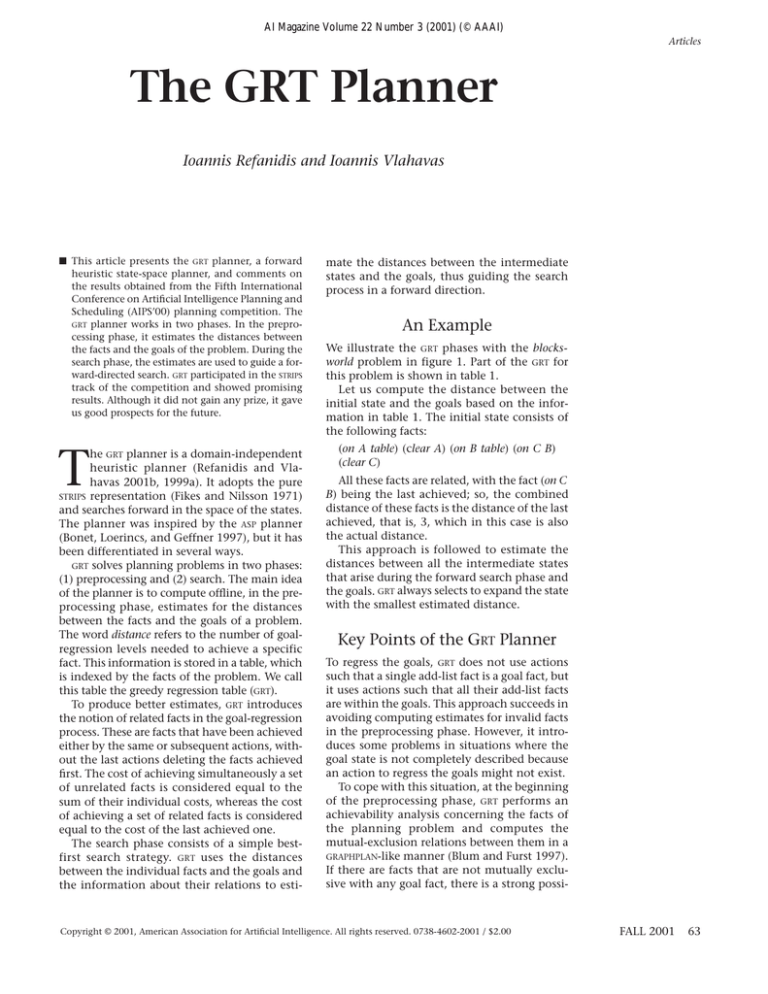
AI Magazine Volume 22 Number 3 (2001) (© AAAI)
Articles
The GRT Planner
Ioannis Refanidis and Ioannis Vlahavas
■ This article presents the GRT planner, a forward
heuristic state-space planner, and comments on
the results obtained from the Fifth International
Conference on Artificial Intelligence Planning and
Scheduling (AIPS’00) planning competition. The
GRT planner works in two phases. In the preprocessing phase, it estimates the distances between
the facts and the goals of the problem. During the
search phase, the estimates are used to guide a forward-directed search. GRT participated in the STRIPS
track of the competition and showed promising
results. Although it did not gain any prize, it gave
us good prospects for the future.
T
he GRT planner is a domain-independent
heuristic planner (Refanidis and Vlahavas 2001b, 1999a). It adopts the pure
STRIPS representation (Fikes and Nilsson 1971)
and searches forward in the space of the states.
The planner was inspired by the ASP planner
(Bonet, Loerincs, and Geffner 1997), but it has
been differentiated in several ways.
GRT solves planning problems in two phases:
(1) preprocessing and (2) search. The main idea
of the planner is to compute offline, in the preprocessing phase, estimates for the distances
between the facts and the goals of a problem.
The word distance refers to the number of goalregression levels needed to achieve a specific
fact. This information is stored in a table, which
is indexed by the facts of the problem. We call
this table the greedy regression table (GRT).
To produce better estimates, GRT introduces
the notion of related facts in the goal-regression
process. These are facts that have been achieved
either by the same or subsequent actions, without the last actions deleting the facts achieved
first. The cost of achieving simultaneously a set
of unrelated facts is considered equal to the
sum of their individual costs, whereas the cost
of achieving a set of related facts is considered
equal to the cost of the last achieved one.
The search phase consists of a simple bestfirst search strategy. GRT uses the distances
between the individual facts and the goals and
the information about their relations to esti-
mate the distances between the intermediate
states and the goals, thus guiding the search
process in a forward direction.
An Example
We illustrate the GRT phases with the blocksworld problem in figure 1. Part of the GRT for
this problem is shown in table 1.
Let us compute the distance between the
initial state and the goals based on the information in table 1. The initial state consists of
the following facts:
(on A table) (clear A) (on B table) (on C B)
(clear C)
All these facts are related, with the fact (on C
B) being the last achieved; so, the combined
distance of these facts is the distance of the last
achieved, that is, 3, which in this case is also
the actual distance.
This approach is followed to estimate the
distances between all the intermediate states
that arise during the forward search phase and
the goals. GRT always selects to expand the state
with the smallest estimated distance.
Key Points of the GRT Planner
To regress the goals, GRT does not use actions
such that a single add-list fact is a goal fact, but
it uses actions such that all their add-list facts
are within the goals. This approach succeeds in
avoiding computing estimates for invalid facts
in the preprocessing phase. However, it introduces some problems in situations where the
goal state is not completely described because
an action to regress the goals might not exist.
To cope with this situation, at the beginning
of the preprocessing phase, GRT performs an
achievability analysis concerning the facts of
the planning problem and computes the
mutual-exclusion relations between them in a
GRAPHPLAN-like manner (Blum and Furst 1997).
If there are facts that are not mutually exclusive with any goal fact, there is a strong possi-
Copyright © 2001, American Association for Artificial Intelligence. All rights reserved. 0738-4602-2001 / $2.00
FALL 2001
63
Articles
A
A
C
B
B
C
Initial State
Goal State
Figure 1. A 3-Blocks Problem.
Fact
(on C table)
(on B C)
(on A B)
(clear A)
(on A table)
(clear B)
(on B table)
(clear C)
(on C B)
...
Distance
from Goals
0
0
0
0
1
1
2
2
3
...
Related Facts
—
—
—
—
(clear B)
(on A table)
(on A table) (clear A) (clear B) (clear C)
(on A table) (clear A) (clear B) (on B table)
(on A table) (clear A) (on B table ) (clear C)
...
Table 1. Part of the Greedy Regression Table for the 3-Blocks Problem.
bility that the goals do not form a complete
state, and these facts are candidates to enhance
them (Refanidis and Vlahavas 1999b). GRT supports several strategies to select which of the
candidate facts to use to enhance the goals.
In some cases, there is also the need to enrich
the predicate set of the domain. The situation
arises in domains where negative facts are
implicitly present in the initial state and the
preconditions of the actions, as happens with
the boarded and served facts of the elevator
domain at the competition (a similar situation
arose in the movie domain at the AIPS’98 competition). In such cases, GRT defines, at run time,
the negative predicates (that is, not-boarder,
not-served); it modifies the action schemas of
the domain accordingly; and it adds new facts
in the initial state. The identification of this situation is based on the detection of noninitial
64
AI MAGAZINE
state facts, which are not mutually exclusive
with any initial state fact, in a way similar to
the goal-enhancement process.
Comments on the Results
In the logistics domain, the GRT planner was
able to solve fast all the problems, and it produced good plans. In the blocks-world
domain, GRT solved only the small problems
(as many as nine blocks), unable to scale up to
the bigger ones. GRT faced difficulties with the
specific action representation, that is, the
actions stack/unstack and push/pop. We know
from our experience that if move actions were
used instead, GRT could easily solve problems
with more than 20 blocks.
The schedule domain was of the ADL type,
and STRIPS planners did not take part. However,
experiments with GRT and an unofficial STRIPS
version of this domain exhibited very good
performance and good scalability.
In the FreeCell domain, GRT did not solve the
larger problems for two reasons: First, the competition version of GRT did not instantiate
actions, the arguments of which were not pairwise different, a situation that arises in this
domain. Second, this version did not utilize a
closed list of visited states to avoid revisiting
them, a feature that would be valuable in this
domain. A newer version of GRT, without these
two weaknesses, is able to solve almost all the
FreeCell problems. Note that the exploitation of
a closed list of visited states improves the performance of GRT in the blocks-world domain as
well, regardless of the representation that is used.
Articles
Finally, in the elevator domain, GRT solved
all the problems very fast. In this domain, the
use of the enriched predicate set was quite
advantageous.
Recent Extensions
In the last year, GRT has been extended in two
ways. The first extension concerns the avoidance of local optimal states of the heuristic
function by exploiting domain-specific knowledge in the form of state constraints. The new
planner, GRTSC, uses this knowledge to decompose a complex problem in easier subproblems
that have to be solved in sequence (Refanidis
and Vlahavas 2000a). The second extension,
MO - GRT , concerns generating and evaluating
plans on the basis of multiple criteria, such as
duration, cost, safety, and planning time
(Refanidis and Vlahavas 2001, 2000b).1
Conclusions
The competition results have shown that the
performance of the domain-independent
heuristic planners is strongly affected by the
representation of the domains. As for GRT, its
performance varies significantly over the two
alternative blocks-world representations; however, the observation concerns other similar
planners too. We know also that different planners are better in different domains, so it would
be interesting to investigate which features of
the domains favor specific planning techniques and approaches. In any case, we believe
that the heuristic state-space planners have
good prospects in the area of domain-independent planning.
Note
1. All GRT-related stuff is available at www.csd.auth.
gr/~lpis/grt/main.html.
References
Blum, A., and Furst, M. 1997. Fast Planning through
Planning Graph Analysis. Artificial Intelligence
90(1–2): 279–298.
Bonet, B.; Loerincs, G.; and Geffner, H. 1997. A
Robust and Fast Action Selection Mechanism for
Planning. In Proceedings of the Fourteenth National
Conference on Aritificial Intelligence, 714–719. Menlo Park, Calif.: American Association for Artificial
Intelligence.
Fikes, R. E., and Nilsson, N. J. 1971. STRIPS: A New
Approach to the Application of Theorem Proving to
Problem Solving. Artificial Intelligence 2(3–4):
189–208.
European Conference on Planning (ECP-99),
347–359. Durham, U.K.: Springer.
Refanidis, I., and Vlahavas, I. 1999b. On Determining
and Completing Incomplete States in STRIPS Domains.
In Proceedings of the IEEE International Conference
on Information, Intelligence, and Systems, 289-296.
New York: IEEE Computer Society.
Refanidis, I., and Vlahavas, I. 2000a. Exploiting State
Constraints in Heuristic State-Space Planning. In Proceedings of the Fifth International Conference on AI Planning and Scheduling Systems (AIPS’00), 363-370. Menlo
Park, Calif.: AAAI Press.
Refanidis, I., and Vlahavas, I. 2000b. Heuristic Planning with Resources. In Proceedings of the Fourteenth
European Conference on AI (ECAI-00), 521–525. Amsterdam: IOS.
Refanidis, I., and Vlahavas, I. 2001a. A Framework for
Multi-Criteria Plan Evaluation in Heuristic StateSpace Planning. Paper presented at the Seventeenth
International Conference on Artificial Intelligence
(IJCAI-01) Workshop on Planning with Resources,
4–10 August, Seattle, Washington.
Refanidis, I., and Vlahavas, I. 2001b. The GRT Planning System: Backward Heuristic Construction in
Forward State-Space Planning. Journal of Artificial
Intelligence Research. Forthcoming.
Ioannis Refanidis received his B.S.
in physics in 1992, his B.S. in computer science in 1997, and his
Ph.D. in computer science (heuristic planning systems) in 2001 from
the Aristotle University of Thessaloniki, Greece. Currently he is
working as a researcher in the
Department of Computer Science
at the Aristotle University. His research interests
include planning, resource reasoning, multicriteria
evaluation, and software engineering. He is a member of AAAI and the executive council of the Greek
Society on Artificial Intelligence. His e-mail address is
yrefanid@csd.auth.gr.
Ioannis Vlahavas is an associate
professor in the Department of
Informatics at the Aristotle University of Thessaloniki. He received
his Ph.D. in computer science (logic programming systems) from the
Aristotle University in 1988. He
specializes in logic programming
and knowledge-based and AI systems. He teaches graduate- and postgraduate-level
courses in logic programming, AI, expert systems,
and decision support systems. He has been involved
in more than 10 research projects, leading most of
them. He is a member of the Greek Physics and Computer Societies, IEEE, and the Association for Logic
Programming. His e-mail address is vlahavas@csd.
auth.gr.
Refanidis, I., and Vlahavas, I. 1999a. GRT: A DomainIndependent Heuristic for STRIPS Worlds Based on
Greedy Regression Tables. In Proceedings of the Fifth
FALL 2001 65
Articles
ADVANCES IN
DISTRIBUTED AND PARALLEL
KNOWLEDGE DISCOVERY
Edited by Hillol Kargupta and Philip Chan
K
nowledge discovery and data mining (KDD) deals with the problem of
extracting interesting associations, classifiers, clusters, and other patterns
from data. The emergence of network-based distributed computing environments has introduced an important new dimension to this problem—distributed
sources of data. Distributed knowledge discovery (DKD) works with the merger of
communication and computation by analyzing data in a distributed fashion. This
technology is particularly useful for large heterogeneous distributed environments
such as the Internet, intranets, mobile computing environments, and sensor networks. When the datasets are large, scaling up the speed of the KDD process is crucial. Parallel knowledge discovery (PKD) techniques addresses this problem by using
high-performance multi-processor machines. This book presents introductions to
DKD and PKD, extensive reviews of the field, and state-of-the-art techniques.
PUBLISHED BY THE AAAI PRESS / COPUBLISHED BY THE MIT PRESS
Five Cambridge Center, Cambridge, Massachusetts 02142 USA
http://mitpress.edu/ • 617-625-8569 • 800-356-0343
ISBN 0-262-61155-4, 472 pp., illus., bibliography, index
66
AI MAGAZINE

